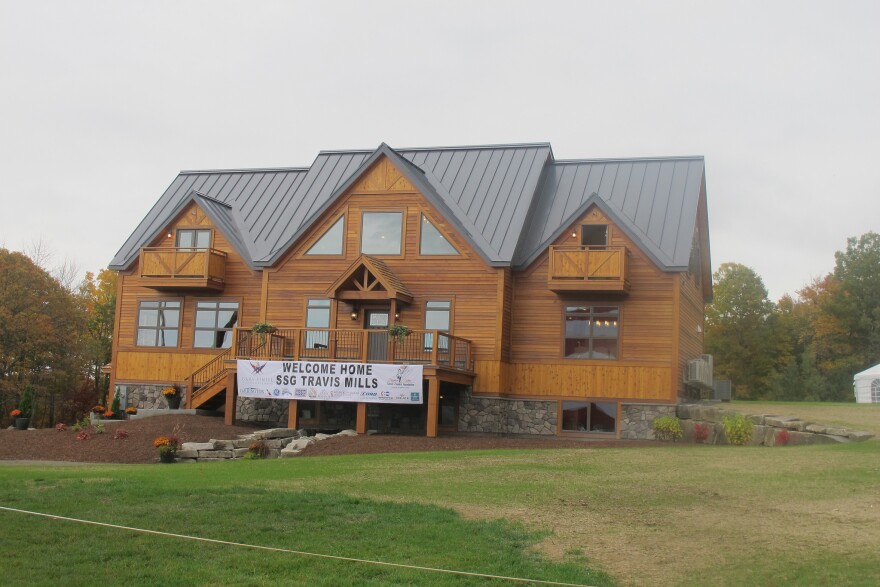There were emotional scenes in Manchester, Maine, this morning, as a critically injured war veteran was presented with a specially adapted, custom-built home. The so-called "Smart Home" - which can be controlled by a hand-held computer - was built with the help of a foundation set up by Hollywood actor Gary Sinise.

On April 10, 2012, Army Staff Sgt. Travis Mills was on his third tour in Afghanistan when he stepped on a land-mine. He lost portions of both arms and both legs, and became the fifth quadruple amputee from the wars in Iraq and Afghanistan to survive his injuries.
Two-and-a-half years later, Mills - who's originally from Michigan - arrives at his new home in style: in a motorcade, the guest of honor at a special dedication ceremony.
Using prosthetic legs, Mills walks unaided onto the stage, which is set in front of a giant American flag. Behind the flag is the soon-to-be-unveiled 4,000-square-foot, $600,000 home.

The imposing residence was built with the help of a couple of non-profits, including the Gary Sinise Foundation, a group set up by the Hollywood actor, perhaps best known for his portrayal of Lt. Dan Taylor in the movie Forrest Gump. Sinise, who was unable attend this ceremony, set up the organization in 2011 to honor and help veterans, first responders, and their families.
The Foundation's Chris Kuban says the specially-adapted home is a way of saying thank you to people like Travis Mills. "Thank for your service, your sacrifice, your determination, and your resolve to be strong through the whole process," Kuban said. "We hope that this house will give you and family the independence that most of us take for granted every single day."
"You've been through the ringer enough, you've done enough for me for a lifetime," Mills said to his wife, Kelsey, struggling to hold back tears as Kelsey joined him on the stage, along with their 3-year-old daughter, Chloe. "So I'm happy, yeah, yeah, yeah, so I'm proud to be moving to Maine."
Mills' struggle to overcome his injuries is the subject of an award-winning documentary and has garnered him much national attention. Despite his disabilities, the former athlete has stayed active through snowboarding, skiing and skydiving, He now devotes himself to helping other injured veterans, and travels the country as a motivational speaker.

The most important thing, he says, is staying positive. "And there's guys didn't make it back home, there's guys that never will make it back home, and their families would love to have them in my situation," he said. "And the doctors and nurses and therapists and everyone at Walter Reed that worked so hard and tirelessly to keep me alive - and there's a couple of times I almost faded out - it would just be selfish on my part to give up."
"So this is the man cave area, coming through the garage," Mill says later, as he takes members of the press on a tour his new home. One of his favorite features is what he calls his "man cave" in the basement, where he plans to retreat to watch sports on TV when the rest of the family is asleep. The home's three storeys are connected by an elevator.
As a so-called "Smart House," many of the home's features are controlled with the touch of a computer screen. "You can run everything off your iPad or your iPhone," he says.
Maine native Kelsey Mills says the smart features give her husband a lot more control over his life. "It's just really convenient if Travis is here by himself, he doesn't have to come downstairs and turn the lights off or turn the alarm on - he can do it all from the iPad," she says.
"A 'Smart House' is a home that will allow the veteran to be more independent," says Judith Otter, executive director of the Gary Sinise Foundation. She says this is the 13th Smart House to be completed this year, with 11 more due to be built next year. Each one, she says, is designed to meet the specific needs of the veteran who's moving in.
"The kitchen sink could lower, the stovetop could lower, the cabinets could lower, depending on if the veteran wants that option."
And in the case of amputees such as Travis Mills, she says it's also important to keep room temperatures steady to avoid overheating.
Despite the work being done by organizations like the Gary Sinise Foundation, Otter says there's still a big unmet need. In all, she says, there are about 1,900 severely wounded veterans out there who qualify for specially-adapted housing grants.


